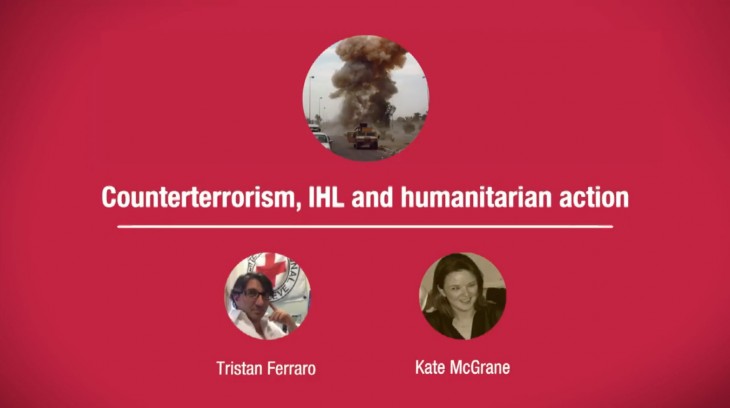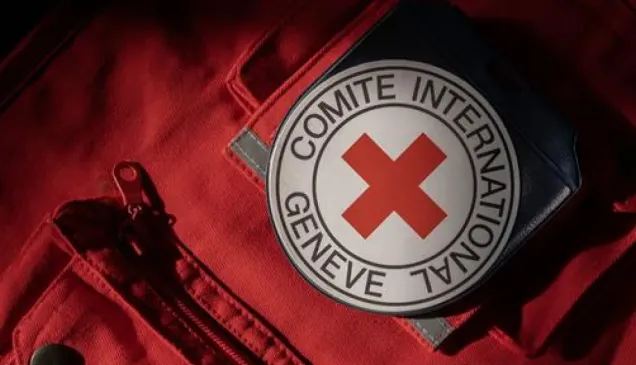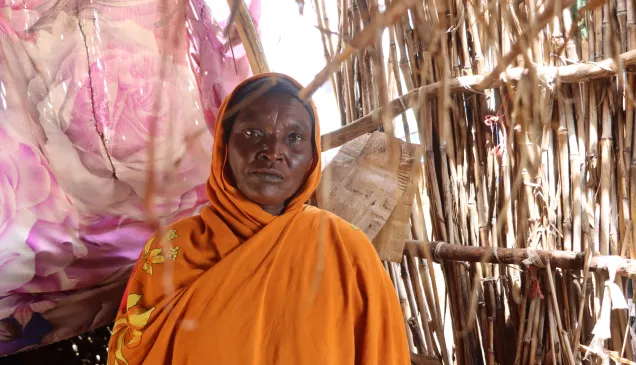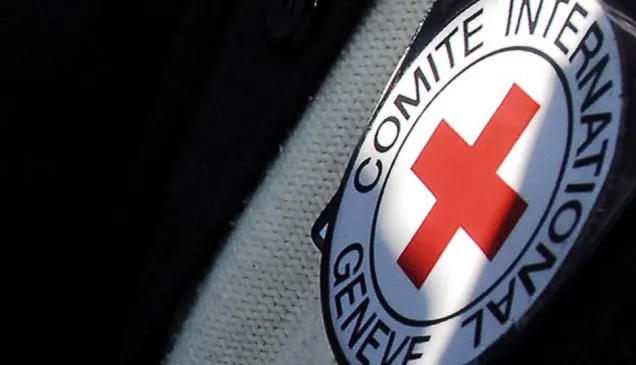Counterterrorism, IHL and Humanitarian Action
The Advanced IHL Learning Series are addressed to lecturers and trainers who wish to be abreast of the latest developments in international humanitarian law (IHL) and other related areas. The series help lecturers strengthen their grasp of topical issues and gives them access to teaching resources, thereby enabling them to introduce these topics or issues in the courses or training sessions that they run.
The Advanced IHL Learning Series combines theory and practice; it makes use of videos, reading materials and various other teaching tools. Many of the resources are taken from the 2015 edition of the Advanced Seminar in IHL for University Lecturers and Researchers. The videos feature lectures by speakers at the seminar, and discussions between them and participants. The opinions expressed by the lecturers in the series are theirs alone, and not necessarily shared by the ICRC.
Introduction to counterterrorism, IHL and humanitarian action
The last decade has seen a surge in terrorism. In response, States have taken numerous measures to combat it. While pursuing legitimate aims, counterterrorism measures can have a considerable impact on how or whether States fulfil their obligations under international humanitarian law, as well as on impartial humanitarian action in armed conflict.
While IHL does not provide a comprehensive definition of terrorism it prohibits “[a]cts or threats of violence the primary purpose of which is to spread terror among the civilian population” (Additional Protocol 1, Article 51(2); see also Geneva Convention IV, Article 33(1) and Additional Protocol II, Article 4(2)(d)). In that sense, IHL and the legal framework governing counterterrorism share common ground. However, both regimes also contain major differences and thus need to be distinguished: IHL regulates both lawful and unlawful acts of violence whereas, within the legal framework governing counterterrorism, all acts of violence labelled as “terrorist” are generally considered to be unlawful.
The relationship between IHL and the counterterrorism legal framework has often been the object of misconceptions. Whereas IHL does not apply as a whole to the “global fight against terrorism” it is applicable in some contexts concerned by it, provided the criteria to classify those situations as armed conflicts are met. This has raised several questions: does IHL apply to non-State armed groups considered terrorists? Is IHL adapted to address the threat emanating from those groups? Can the applicability of IHL lead to impunity for those committing terrorist acts in armed conflict? Dealing with these issues has been increasingly difficult because of the current narrative supported by counterterrorism measures. It reflects the tendency of States to consider any act perpetrated by non-State armed groups as terrorist, unlawful and subject to prosecution. Some States also believe the applicability of IHL to a situation can give legitimacy to non-State armed groups. This narrative blurs the lines between armed conflict and terrorism with potentially adverse effects on the applicability and integrity of IHL.
Counterterrorism measures also affect humanitarian action. There has been a proliferation of measures – most notably in UN Security Council Resolutions – that place limits on or even prohibit humanitarian organizations from providing impartial humanitarian aid in practice. For example, too general and absolute a prohibition on material and financial support to terrorists or people associated with terrorist groups (that could include close or distant relatives, even if not involved in terrorist activities at all) will prevent or delay humanitarian assistance to affected populations. In this context, conducting impartial humanitarian activities according to the most urgent and pressing needs within the IHL framework, becomes increasingly difficult. There is therefore a growing concern over the risk that humanitarian actors could be prosecuted for having provided lawful, impartial and humanitarian aid. The security of their local staff in charge of such relief operations could also be cause for concern.
The interactions between IHL and the counterterrorism legal framework create challenges that need to be addressed. When counterterrorism measures are adopted – as legitimate as they are – it is important to ensure that they respect the integrity of IHL and preserve the imperative of humanitarian action. Beyond preserving human dignity in armed conflict, respect for humanitarian law and action can also represent an important way to start addressing the root causes of terrorism.
Learning objectives
At the end of the series, lecturers will be able to:
- identify the challenges raised by the impact of counterterrorism measures on IHL and humanitarian action in armed conflict;
- explain the relevance of IHL applicability to counterterrorism operations;
- describe the relationship between IHL and the counterterrorism legal framework;
- explain how counterterrorism measures and humanitarian action intersect, particularly in the sense that there will always be some risk. There can never be a guarantee that humanitarian aid will not end up in the hands of a terrorist group. Risk can never be eliminated;
- identify and describe the lawful steps organizations can take to mitigate the impact of counterterrorism measures on humanitarian assistance.
Structure of the course
1. Required and suggested reading: before watching the videos, lecturers and humanitarian professionals are invited to familiarize themselves with the topic by working their way through the required and suggested reading.
2. Videos: the entire session can then be watched at once, or by chapter, depending on the need and specific interest of each user. Videos can also be watched and discussed in class, as an introduction to the topic triggering questions and debate.
3. Teaching tools: ICRC tools on how to teach IHL as well as specific, ready-to-use teaching materials on IHL and humanitarian principles are available. Lecturers are encouraged to use them to incorporate the topic in their course or training.
4. Further reading and resources: lecturers and humanitarian professionals are encouraged to further explore the topic via additional resources (e.g. ICRC statements, publications, event reports) about IHL and humanitarian principles and related topics. Researchers may wish to use them as sources for their research projects.
Speaker biographies
Tristan Ferraro, ICRC
Tristan Ferraro is a senior legal adviser at the Legal Division of the ICRC. He is responsible for legal issues relating to multinational forces, occupation, protection of civilians and the notion of armed conflict. He is also in charge of the files relating to humanitarian access and to IHL & terrorism. Before coming back to the Legal Division at the ICRC HQ in 2007, he has served with the ICRC in the field, in particular as legal coordinator in Afghanistan, Pakistan and Israel/Palestinian occupied territory. Prior to joining the ICRC in 2002, he worked as senior lecturer at the University of Nice-Sophia Antipolis, teaching inter alia Public International Law, including IHL. He is a Doctor of Laws, which he earned (summa cum laude) at the University of Nice-Sophia Antiopolis.
Kate McGrane, Norwegian Refugee Council (NRC)
Kate McGrane is the Senior Humanitarian Policy adviser at NRC Geneva, specializing in the impact of counterterrorism measures and countering violent extremism with regard to principled humanitarian action. In 2015 she co-authored NRC’s Risk Management Toolkit in Relation to Counterterrorism Measures. More recently, she drafted the NRC’s first paper on countering violent extremism in relation to humanitarian action. Prior to joining the NRC in Geneva in 2015, she spent eight years managing humanitarian and development programmes for NGOs in East and Central Africa, and the Middle East.
Reading material
Required reading
- ICRC, “The applicability of IHL to terrorism and counterterrorism”, 2015: https://www.icrc.org/en/document/applicability-ihl-terrorism-and-counterterrorism
- Ben Saul, "Terrorism and International Humanitarian Law", Research Handbook on International Law and Terrorism, 2014, pp. 208–231.
- Norwegian Refugee Council, Risk Management Toolkit in Relation to Counterterrorism Measures, 2015.
- Kate Mackintosh and Patrick Duplat, Study of the Impact of Donor Counterterrorism Measures on Principled Humanitarian Action, Norwegian Refugee Council and Office for the Coordination of Humanitarian Affairs, 2013.
- Marco Sassòli, "Terrorism and War", Journal of International Criminal Justice, Volume 4, Issue 5, 2006, pp. 959–981.
- UN Security Council Resolution 1373
- UN Security Council Resolution 2178
Suggested reading
- ICRC, International Humanitarian Law and the Challenges of Contemporary Armed Conflicts, section II(3) on the applicability of IHL to terrorism and counterterrorism, 2015, pp. 16–21, section VI on the conflation of IHL and the legal framework governing terrorism, 2011, pp. 48–53.
- ICRC, "Terrorism": https://www.icrc.org/en/war-and-law/contemporary-challenges-for-ihl/terrorism
- Ben Saul, "Humanitarian action, development and terrorism", Research Handbook on International Law and Terrorism, 2014, pp. 315–332.
- Norwegian Refugee Council, Countering Violent Extremism and Humanitarian Action, 2017.
- ICRC and College of Europe, Terrorism, Counter-Terrorism and IHL, 17th Bruges Colloquium, 20–21 October 2016, pp. 5-182.
- Naz K. Modirzadeh, Dustin A. Lewis and Claude Bruderlein, "Humanitarian engagement under counter-terrorism: A conflict of norms and the emerging policy landscape", International Review of the Red Cross (IRRC), No. 883, 2011, pp. 623–647.
- Claudia McGoldrick, "The future of humanitarian action: An ICRC perspective", IRRC, No. 884, 2011, pp. 965–991.
- Dustin A. Lewis, Naz K. Modirzadeh, Gabriella Blum, "Medical care in armed conflict: International humanitarian law and state responses to terrorism", Harvard Law School Program on International Law and Armed Conflict, 2015.
- Jelena Pejic, "Armed conflict and terrorism: There is a (big) difference", in Counter-terrorism, International law and practice, OUP, 2012, pp. 171-204.
Videos
The course is divided into several sessions. Click on a title to watch the video.
- 1. Outline of the session
- 2. Introduction: counterterrorism, IHL and humanitarian perspectives
- 3. The applicability of IHL in the "fight against terrorism"
- 4. IHL and the legal framework governing terrorism
- 5. Principled humanitarian activities
- 6. The impact of counterterrorism measures on principled humanitarian activities
- 7. Mitigating the impact of counterterrorism measures on humanitarian action
- 8. Future challenges
Specific teaching tools on counterterrorism, IHL and humanitarian action
- Nils Melzer, International Humanitarian Law: A comprehensive introduction, ICRC, Geneva, 2016, pp. 37–39.
- ICRC, "What does IHL say about terrorism?", Extract from ICRC, International Humanitarian Law: Answers to Your Questions, pp. 80–84.
- The Future of Humanitarian Action, IRRC, No. 884, 2011.
- ICRC: 150 years of Humanitarian Action, IRRC, No. 888, 2012.
- Ready-to-use workshop on principles guiding humanitarian action.
- E-briefing on principles guiding humanitarian action.
- How Does Law Protect in War? website, see glossary entry: Terrorism and terrorists.
- How Does Law Protect in War? website, see glossary entry: War on terror.
- How Does Law Protect in War? website, see glossary entry: Humanitarian assistance.
- How Does Law Protect in War? website, see glossary entry: Terror (spreading of).
- How Does Law Protect in War? website, case-study: Syria, Press conference with French President Francois Hollande and Russian President Vladimir Putin.
- How Does Law Protect in War? website, case-study: United States, Hamdan v. Rumsfeld.
- How Does Law Protect in War? website, case-study: United States of America, Holder v. Humanitarian Law Project.
Further reading and resources
- Ellen Policinsky, "Terrorism, counter-terrorism and IHL: Primer on a recurring conversation", International Law and Policy Blog, 2016.
- Stéphane Ojeda, "Global counter-terrorism must not overlook the rules of war", International Law and Policy Blog, 2016.
- Stéphane Ojeda, "Global counter-terrorism & the laws of war", International Law and Policy Blog, 2017.
- Statement of Christine Beerli, ICRC vice-president at the 17th edition Bruges Colloquium, 20–21 October 2016.
- Andrej Zwitter, "Humanitarian action on the battlefields of the global war on terror", The Journal of Humanitarian Assistance, 2008.
- Sara Pantuliano, Kate Mackintosh and Samir Elhawary, "Counter-terrorism and humanitarian action, tensions, impact and ways forward", HPG Policy Brief 43, 2011.
- Dr Phoebe Wynn-Pope, Yvette Zegenhagen and Fauve Kurnadi, "Legislating against humanitarian principles: A case study on the humanitarian implications of Australian counterterrorism legislation", IRRC, No. 897/898, 2015, pp. 235–261.
- Emanuele Sommario, "The status of foreign fighters under international humanitarian law" in Foreign fighters under International Law and Beyond, 2016, pp. 141–160.
- Hans-Peter Gasser, "International Humanitarian Law, the prohibition of terrorist acts and the fight against terrorism", Yearbook of International Humanitarian Law, 2004, pp. 329–347.




